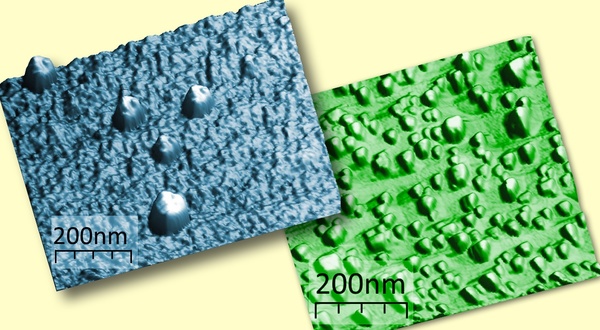|
an team of physicists that included researchers from the institute of nuclear physics of the polish academy of sciences (ifj pan), the karlsruhe institute of technology (kit) in germany, and the european synchrotron (esrf) in france have detailed how the vibrations of the atoms in the crystal lattice (phonons) of europium silicide (eusi2) change depending on the nanostructure arrangement on a substrate of silicon.

microscopic images of the europium silicide nanoislands on the silicon surface. the nanoislands are
completely isolated (left) or adjoining each other (right). (source: ifj pan)
according to a report from ifj pan, the scientists observed a new type of vibration when eusi2 nanoislands were in contact with each other. this breakthrough leads the scientists to believe that this could lead to phonon nanoengineering in which not only the structure of the material but also its phonons can be designed to get the desired properties.
europium silicide crystals are formed by a single europium atom surrounded by 12 silicon atoms. the compound readily binds to silicon and has a record-low schottky barrier, which makes it an interesting material for potential use in nanoelectric systems, such as mosfet technology.
the article explained, “although compounds of rare earth metals and silicon play a fundamental role in heat transport, among others, their lattice vibrations have not to date been comprehensively studied. meanwhile, in nanoelectronic systems where heat is generated in large amounts, thermal properties of a material became as important as the magnetic or electric properties.”
in ultrahigh vacuum conditions, researchers placed small amounts of europium atoms on a heated substrate of single crystalline silicon. the scientists were able to form nanoislands, some in contact with each other and others isolated. these structures were studied through nuclear inelastic scattering, which measures the energy spectrum of atomic vibrations with very high resolution.
“in the case of a substrate coated with discrete nanoislands a significant increase of the amplitude of vibration of europium atoms was observed, up to 70% relative to the vibrations in the crystal,” the article added. “such a large increase translates into significantly greater possibilities in the field of heat transfer.”
when the nanoislands were in contact with each other then they provided gateways for thermal conductivity and for the material to dissipate heat to the environment.
the research was recently published in physical review letters. the abstract read:
“in the case of a substrate coated with discrete nanoislands a significant increase of the amplitude of vibration of europium atoms was observed, up to 70% relative to the vibrations in the crystal. such a large increase translates into significantly greater possibilities in the field of heat transfer.
“the most interesting effect appeared, however, in the sample with nanoislands adjoining each other. namely, additional vibrations with a characteristic energy were found at the interfaces between the nanoislands. although theoretically predicted earlier on, their existence was confirmed experimentally for the first time.
“they constitute another 'gateway' through which material can discharge heat into the environment. by means of the adjoining nanoislands a significant increase in the efficiency of heat transfer in nanostructures becomes a reality.”
|